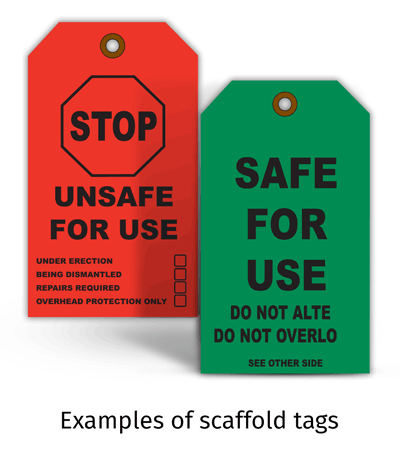Using Scaffolding Safety Tags
Why are scaffolding safety tags important?

Scaffolding safety tags are an important resource for the use of any type of scaffold. Scaffolds can be the source of multiple types of hazards in the workplace, including falls and falling objects. By tagging equipment, workers can know if scaffolding has been inspected or is safe to use.
Scaffolding safety tags are typically used after an inspection of the scaffold. The most common system of tagging involves using red tags for unsafe or incomplete scaffolds, and green tags for scaffolds that are ready for use.
Tagging occurs at any access point, including ladders or ramps. OSHA standard 29 CFR 1926.415(e)(1) prohibits crossbraces from being used to access the scaffolding.
At these access points, tags noting that the scaffold is safe for use, unsafe, under construction, or for use with a specific weight limit can be attached.
Scaffolding safety tags can also hold inspection record information, such as the date of the last inspection or modification to the scaffold’s structure.
Safety signs for scaffolds can also be posted outside of the scaffold area to alert workers of jobsite policies and related safety information, such as the potential need for the use of hard hats and other personal protective equipment.
What is OSHA?
OSHA is the Occupational Safety and Health Administration – a public health agency that is part of the Department of Labor. OSHA sets and enforces workplace safety regulations. Learn more here.
What happens during an OSHA inspection?
During an OSHA, inspectors will review previous records, inspect potential on-site hazards, and interview employees. OSHA’s inspections are prioritized by how potentially hazardous a workplace might be to workers. Learn more here.
What do I need to pass an OSHA inspection?
There are many elements of a safe workplace that factor into passing an OSHA inspection. Dependent on your industry, the posting of official safety signs, use of protective equipment, and proper training could help in successfully passing an inspection. Learn more here.
SafetySign.com does not recommend or specify the use of a specific safety sign because it does not have knowledge of the hazard(s) our customers are identifying. It is the customer’s sole responsibility to identify the hazard(s) that may be present and select one or more signs (stock or custom) that accurately identify their specific hazard(s) and complies with any applicable federal, state or local laws or regulations, any worksite specific rules or regulations and/or any applicable safety standards (including, without limitation, ANSI and/or OSHA standards). SafetySign.com disclaims any and all liability (excluding liability for our Product Warranty contained in our Terms and Conditions) for any sign selected by a customer and shall not be responsible for any personal injury or property damage resulting from the use of signs purchased from it or for the independent interpretation made of any applicable federal, state or local laws or regulations, any worksite specific rules or regulations, and/or any applicable safety standards (including, without limitation, ANSI and/or OSHA standards). Customer shall indemnify and hold SafetySign.com and its corporate parent and its officers, directors and affiliates harmless from and against any and all claims, loss or expense (including attorneys’ fees) arising from or related to the purchase and use by customer or any third party of any sign purchased by customer from SafetySign.com.
